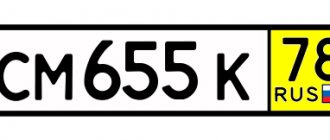Recycling algorithm
Disposal of a vehicle means its safe destruction. Machines are made of metal, plastic, glass, and technical fluids. If you leave it and forget about it, over time, harmful substances will begin to enter the soil and atmosphere.
Recycling involves the safe recycling of vehicles. The car is disassembled by employees of a special organization, the materials are sorted and sent for further processing.
To recycle a car you must:
- Deregister the vehicle with the traffic police. Most scrap vehicle collection points require a certificate of deregistration of the vehicle.
- Drop the car off at a collection point. It is necessary to conclude a disposal agreement with the organization.
There are quite a lot of companies that deal with recycling. The service is provided free of charge. But sometimes a fee is charged for accepting a vehicle with a low mass (less than 800 kg).
To deregister a car you need the following documents:
- Russian passport;
- vehicle registration certificate, vehicle passport, license plates;
- application in the prescribed form;
- The vehicle is not provided for inspection.
Disposal conditions:
- aging and wear and tear of the vehicle;
- The vehicle was sold under a general power of attorney, but the new owner does not appear at the State Traffic Safety Inspectorate to re-register the car in his name (in order not to continue to pay transport tax, the seller of his car has to deal with an extreme measure - the disposal procedure);
- car theft;
- eliminating accidents on the roads due to the difficulty of moving an old car along them.
Remember: if your car has been deregistered by the traffic police, you no longer have the right to drive it. Transport the car only on a tow truck.
Next, you need to visit the traffic police department and get a certificate of deregistration of the car due to disposal.
Conditions for removing a car from state registration:
- recycling according to the state program;
- unlawful actions in relation to a car, theft;
- if the car buyer has not registered the car and does not intend to do so;
- leaving the country for a long time (then the owner registers the car in the country of residence).
Procedure for completing the procedure:
- contact the traffic police in person, join the electronic queue;
- there is no need to deliver the old car to the traffic police for inspection;
- submit the completed application and documents;
- The car owner is given the necessary certificate.
You can then dispose of the vehicle yourself (disassemble and sell for parts) or with the help of a private recycling company.
The conditions and cost of the service are specified in each company separately. Representatives will ask you to provide them with a certificate from the traffic police.
Sample application
Let's look at a sample of filling out an application for recycling a car at the traffic police:
- indicate the exact name of the traffic police department where you are going to submit documents;
- FULL NAME;
- underline the appropriate wording of the reason for deregistration of the vehicle (in connection with disposal);
- fill in the form from the vehicle passport with information about the make, model of the car, VIN number, state signs, year of manufacture;
- enter the passport details of the car owner, fill out information about the owner;
- rewrite the information about the vehicle in the required lines.
Power of attorney for disposal
A power of attorney is a necessary document for deregistering a car if the car owner cannot visit the traffic police department himself. The document must be drawn up correctly.
The power of attorney from a legal entity indicates:
- number, date of compilation;
- full name and address of the organization;
- position, full name of the principal;
- Full name, address, passport details of the authorized person;
- the registration department of the traffic police to which you intend to apply;
- car data (make, license plates, VIN code, year of manufacture, chassis number, body number, engine number);
- car registration certificate, its passport;
- validity period (valid for 1 year);
- signature of the authorized person, principal.
A car owner who wants to scrap a vehicle can only submit a passport and a recycling application. But if for some reason he cannot carry out the procedure himself, he issues a power of attorney to his representative. Then the document is certified by a notary.
A power of attorney from an individual shall indicate:
- place, date of compilation;
- Full name, passport details, address of the principal and authorized representative;
- traffic police registration office;
- vehicle data;
- car passport numbers and registration certificate;
- validity period of the power of attorney;
- signatures of the parties.
Let's look at how to scrap a car under a special program and what documents are needed.
Car recycling
The modern auto recycling scheme includes the following stages:
- draining fuel and lubricants on mobile units;
- dismantling of vehicles with preliminary sorting by type of materials;
- shredding unusable car parts using shredder units;
- cleaning from dust and dirt, sorting and separating non-metallic parts;
- Briquetting of secondary materials.
The auto recycling system must provide:
- Formation of a regulatory framework regulating the activities of all participants in this system.
- Development of infrastructure for the collection, transportation and processing of worn-out parts and vehicles.
- Mechanisms for financing costs associated with the disposal of used vehicles.
- A system of requirements for enterprises involved in vehicle recycling.
- A system of requirements for developers and manufacturers of domestic cars and importers of foreign-made cars.
- A system for monitoring the implementation of the provisions of the federal concept.
During operation, about 25% of the original weight of the car is lost in total. These losses are mainly associated with abrasion of rubber tires, corrosion of metals, as well as repeated replacements of some parts and components of the car, such as: battery (3-4 pieces during operation), tires (about 16), oil and fuel filters, brake pads and some other parts, as well as replacing fuel, lubricants and technical fluids (oils, antifreeze, brake fluid, etc.). All these substances enter the environment and cause damage to it. Some of these materials are lost irretrievably, for example, liquids and metals, when abraded, turn into fine particles. However, most materials end up in landfills and landfills or simply rust somewhere. Some substances can lie in landfills for years and do not undergo any changes in their chemical composition, so all these substances are potential promising resources for their subsequent processing. And if we take into account that the number of used and disused cars is increasing every year, then in 15-20 years, according to experts, their number will be so large that the problem of recycling them will become even more pressing than it is now.
Figure - Materials included in the vehicle
Due to the nature of the materials used in the automotive industry, an out-of-service vehicle is a complex, hazardous waste. Table 5 shows the material content of typical vehicles.
Table 5. Material content in cars
Government program
This special program was launched in 2010, but is still in effect. The goal of the state program is to increase the growth of sales of domestic cars by providing subsidies for the purchase of new vehicles to replace old ones.
The main condition for participation in the program: you can only spend the funds you receive from handing over your vehicle for recycling to purchase a new car.
Other conditions in 2021:
- you must own the car for at least six months;
- Individuals and legal entities can participate in the program;
- new cars are not scrapped;
- the participant must have a Russian passport;
- a car cannot be recycled without a specially hired dealer (services can cost about 10,000 rubles).
According to the program, you can exchange a passenger car, a large car, a jeep, or a bus. The maximum discount amount is 50-350 thousand rubles.
Minimum amount for cars, maximum for trucks. As part of this program, it has already been possible to sell about 130,000 cars.
Only a limited number of models can be purchased under the program: AvtoVAZ, GAZ, UAZ, several models of Volkswagen, Opel, Nissan, Ford, SsangYong, Renault.
Scrapping with the help of a dealer according to the program
All documents are prepared by the dealer, who also enters into an agreement with the client to purchase a new car.
He issues a discount on the purchase of a vehicle in the form of a certificate or cash. Contact participating car dealers and trade in your old car.
Algorithm of actions:
- draw up a power of attorney for the dealership to transfer the old car to scrap;
- enter into an agreement with the dealer, which states that you are handing over the car to the dealer for deregistration and disposal;
- hand over the power of attorney and the car, receive an acceptance certificate for the car.
The recycling program is only suitable for those who own an old car; no one uses it. You can get quite an impressive amount for it.
The state allocated about 10 billion rubles for recycling . The program has a limited duration, so it is worth applying early.
Recycling as part of the vehicle recycling system
Any production system, using labor, material, energy and information resources, creates products.
During operation, products lose their consumer properties, turning into faulty worn-out objects. The current practice - acquired, used, discarded - generates a huge number of worn-out industrial objects that pose a serious danger to environmental systems. In this regard, when designing a machine, designers are faced with two interrelated and largely contradictory tasks. Firstly, it is necessary to design an efficient and reliable machine that stably and efficiently performs the specified functions over the entire longest period of operation. Secondly, it is necessary that at the end of the period of operation the machine is able to stop performing its functions and disappear without major material damage and harmful effects on the environment. A complete solution to this dilemma is currently not possible, since this involves the creation of a machine that, after a programmed time, would itself disappear without a trace or be transformed into a mass of useful materials for recycling.
Recently, a rather capacious concept of “recycling” has appeared, meaning a return to the beginning of the cycle, i.e., the return of the components of a worn-out object that has reached its limiting state to a new life cycle in an updated (restored) or some other transformed form. The purpose of recycling is to solve global issues of saving raw materials, non-renewable resources and energy, as well as environmental protection.
The problem of returning faulty worn-out objects that have lost their consumer properties during operation to a new life cycle can currently be solved in three ways (Fig. 1).
Rice. 1. Schematic diagram of recycling of faulty worn-out objects
The first direction is the renovation of faulty worn-out objects, including their restoration and repair in order to extend their service life, as well as the modernization of objects in order to expand their capabilities and improve technical characteristics within the functional purpose intended by the designer. Renovation of facilities involves a significant reduction in the consumption of non-renewable resources, a reduction in energy intensity, and a reduction in the level of environmental pollution. The economic effect of renovation is determined by the difference in the costs of manufacturing a new product and restoring a worn-out product, attributed to its resource. We have discussed this area in some detail in this tutorial.
The second direction is conversion, which involves the design modification of worn-out objects or their functional components in order to use them for another functional purpose (for example, the use of an aircraft engine to create large air flows when drying grain in industrial elevators or the use of car gearboxes in the designs of various stands for testing of components and assemblies, etc.).
The third direction is economically and environmentally acceptable recycling, which involves the processing and reuse of worn metals, non-metallic materials, and operational technical fluids.
Obviously, the most effective is the renovation direction, in which worn-out machine parts are restored using advanced technologies and methods to nominal sizes and original properties at a cost of 30...50% of the original cost of the products, which has almost pure “savings” in terms of ecology. However, as moral and physical aging occurs, as well as the need to switch to new designs and materials, there will always be a need to recycle machines, and their design should be maximally adapted to this.
In the set of tasks that require urgent solutions, the first place is taken by the task of recycling machines, especially cars, since the share of damage due to the main factors of the negative impact of waste on the environment in the motor transport complex is the highest and amounts to 62.7%.
Recycling is not only and not so much the process of destruction and burial of industrial waste and objects in order to prevent the release of harmful substances into the environment. Recycling itself, in essence, is the “useful use” of non-recoverable objects (objects the restoration of which is impossible or impractical). It is a system that includes a set of technological, design and organizational measures, mainly aimed at collecting, transporting, sorting and processing non-renewable industrial objects in order to obtain secondary products, energy and services.
Apparently, humanity will only be able to create an absolutely environmentally friendly, waste-free technology for recycling machines, including automobiles, only in the future. Therefore, at present, when recycling to one degree or another, there is a need for neutralization and disposal of non-recyclable materials.
To destroy or safely dispose of recycled waste, the following technologies are used: combustion, changing the state of aggregation by chemical treatment (for example, converting liquid waste that can seep into the ground into solid waste), neutralizing or decontaminating toxic waste.
It is preferable to neutralize and dispose of hazardous materials at the site of their formation in order to eliminate the need for their transportation and reduce the risk of environmental pollution. Typically, the total volume of materials to be buried is no more than 20...25% of the total weight of the car.
Currently, automakers' efforts are aimed at creating a car whose materials can be reused after safely recycling 85% of the vehicle's curb weight. And by 2015, in accordance with laws adopted by the European Commission, this share should be increased to 95%.
To achieve this goal, it is first necessary to abandon the use of materials containing non-convertible or toxic substances that can cause harm to humans and the environment when disposed of. Thus, various operating fluids (antifreeze, electrolyte, lubricants, etc.), metals, plastics, leather, leather substitutes, rubber, padding, paints, varnishes, etc., from the point of view of their processing technology, react differently to the possibility of their recycling with different quantitative and qualitative content of waste. The safety and efficiency of recycling can be increased by minimizing the amount of materials used (for example, the number of types of plastic can be reduced to two, for example, high-density polyethylene (LDPE) and low-density polyethylene (HDPE), which are modern materials that can be recycled together). It should be borne in mind that the list of substances hazardous during disposal is not always equivalent to the list of hazardous waste due to the fact that a risk factor appears for unfavorable mixing of substances when they are disposed of using the accepted technology.
To provide information about the potential hazards of materials included in the design of a vehicle, they must be marked at the stage of component manufacturing. In this case, a special sign must be installed on the parts, indicating suitability for recycling, as well as a code number indicating the type of raw material used.
When choosing a structural material, it is necessary to pay attention not only to its strength characteristics, its workability (the ability to be easily processed during the technological process of manufacturing products) and ease of use (for example, a lubricant) for its intended purpose, but also to take into account the technological ability of the materials to be easily disassembled and separated from each other. from each other and can also be safely recycled when disposing of the machine.
Based on these requirements, the designed machine, even before putting it into production, must undergo an environmental assessment, not only for compliance with environmental standards during operation, but also during its disposal, including the criterion of the possible return of catastrophically disappearing materials. earth raw materials for recycling.
In the Russian Federation, car recycling has existed for a long time, but it was quite primitive. In Soviet times, the wheels and several other attached parts were removed from the car, after which it was sent under the press. Next, the automobile scrap in the form of a metal briquette entered the smelting furnaces, where ferrous metals were melted, and all non-metallic components were burned, releasing a large amount of toxic substances into the atmosphere.
During the transition to a market economy, the old recycling system ceased to exist, and new economic and legal relations between recycling participants that would stimulate the collection and use of secondary raw materials in new conditions were not created. Specialized enterprises involved in the processing of exhausted vehicles were corporatized and partially switched to other types of activities, which led to a sharp decrease in the collection and use of secondary raw materials.
During this transition period, old cars, bodies, worn-out and damaged automotive components could be found anywhere - in the courtyards of houses, along roads, in deserted places, in unorganized landfills, in enterprises performing maintenance and repair of vehicles. Staying there for a long time in an unsightly form, they polluted urban areas and spoiled natural landscapes. This state of affairs has made the problem of recycling cars and their components (worn out tires, car bodies, lead-acid batteries, oil filters, etc.) one of the most pressing issues.
The state's awareness of the need to address environmental safety issues led to the adoption in 2010 of a program for the disposal of old cars (car recycling). Certain actions and events were held in certain regions of Russia, but the task of creating a full-fledged, cost-effective recycling system was never solved. This happened due to the lack of a regulatory framework that would regulate the relations of all interested parties and would allow creating the infrastructure of modern enterprises for recycling old cars.
The Russian auto recycling program was implemented in the old fashioned way by pressing old cars and transporting scrap automobiles by rail to metallurgical plants, which distributed their products to engineering enterprises, including automobile factories.
Formally, it would seem that the life cycle of the cars is completed - they were safely disposed of, and the recycled materials began a new cycle. However, in essence, such technology can hardly be considered economically and environmentally justified. After all, when pressing a body without first disassembling it, alloyed alloys and non-ferrous metals end up in the briquette along with ferrous metals. Non-metallic components (dirt, glass, plastic, rubber, etc.) remain there. It is estimated that the total mass of the body of an old car contains approximately 10% dirt and glass and about 8% combustible materials. It is technologically impossible to separate them during melting from the total mass of scrap used in the open-hearth process. All this, of course, negatively affects the quality of the steel produced.
True, it is necessary to note the positive aspects that the auto recycling program has brought. First of all, this is the emergence of new processing enterprises that operate using modern technologies based on the use of special equipment, such as shredders (from the English shread - to tear). Unlike a press, a shredder does not briquet the car, but crushes it into small fractions. Scrap of ferrous metals, called meal, obtained using a shredder installation, is characterized by high bulk density and the absence of impurities. Such scrap is a valuable type of raw material for metallurgical production.
Rice. 2. Type of rotary shredder installation
Recycling end-of-life vehicles, if processing enterprises have modern technologies and equipment, could generate profits comparable to industrial production. However, in the presence of large stocks of machines ready for recycling, recycling enterprises are idle or, at best, are loaded at 30...40% of their technical capacities. This paradoxical situation is due to the lack of a systematic state policy in the field of recycling end-of-life vehicles.
It is worth noting some circumstances that must be taken into account when creating the production and technical infrastructure of enterprises for processing old cars.
Car scrap briquettes are considered quite difficult to process due to the large number of non-metallic components present in the car. Therefore, not all scrap buying companies accept old cars for scrap. On the other hand, a worn-out car contains a lot of useful materials (Table 1) that could be reused after recycling. However, the advantage of recycling worn-out materials over destruction does not always apply. Thus, materials are transferred for recycling only if it can be done efficiently using the adopted technology, while obtaining an undoubted economic and environmental effect. Otherwise, waste should be destroyed even by the most primitive methods, as this has less negative impact on the environment.
Table 1
Contents of various materials in the car
| Material | Material content, % | ||
| Typical American car | Typical Japanese car | Typical European car | |
| Steel and alloys | 67,0 | 72,2 | 65,0 |
| Plastic | 8,0 | 10,1 | 12,0 |
| Glass | 2,8 | 2,8 | 2,5 |
| Rubber | 6,0 | 3,4 | 6,0 |
| Technical fluids and oils | 6,0 | 3,4 | 2,5 |
| Other materials (paint, insulation, fabric, electrical wires) | 4,0 | 2,2 | 4,0 |
| Total curb weight of the vehicle, kg | 1438 | 1270 | 1210 |
It should be noted that even in the most modern complete chains of recycling old cars, not all of their links are economically profitable. This is especially true for the organization of collection, transportation and environmentally friendly dismantling. To create a coherent (without bottlenecks) recycling system, it is necessary to create mechanisms for financing all costly operations at the legislative level.
The experience of economically developed countries shows that the problem of recycling worn-out objects can be solved only on the basis of an integrated approach, simultaneously regulating all mechanisms and stages of movement of worn-out objects from the source (individuals and legal entities) to points of dismantling, storage, processing or disposal. But at the same time, public opinion cannot be neglected. Only through active work with the population in environmental education can they be attracted as a participant in the recycling program.
More than 15 years ago, industrialized countries adopted an auto recycling program that dealt with the collection and recycling of worn-out automotive parts and end-of-life vehicles. As part of this program, the handling of used cars is clearly regulated by the regulations of the adopted law on auto recycling, controlled and economically regulated by government agencies - enterprises bear full responsibility for recycling the products they produce.
In a number of European countries, the priorities for processing worn-out objects are defined by law - the bulk of cash flows are aimed at organizing recycling enterprises while simultaneously prohibiting the organization of new open landfills. As a result, conditions have been created under which the burial and incineration of waste, taking into account compliance with all environmental standards, turns out to be three times more expensive than processing this waste into secondary raw materials. As a result, the consumption of recycled products immediately increased.
The necessary funds for car recycling are allocated by states (through the collection of taxes from car owners, car manufacturers and importing companies) and accumulated in special environmental funds at the local and federal levels, and are then used to eliminate bottlenecks in the recycling system.
The auto recycling program includes comprehensive measures for the technical and economic assessment of a worn-out vehicle upon its acceptance, draining of all operating fluids, partial dismantling of attachments, recycling of worn-out objects, reuse of removed parts, melting down of scrap cars, and disposal of non-recyclable waste (mainly plastics, fabrics). Thanks to the auto recycling program, about 35 million cars are recycled annually in the USA, Canada, Japan and Western Europe alone. At the same time, the global recycling industry provides jobs for over one and a half million people. The total value of products made from recycled used vehicles exceeds $250 billion.
If there are no documents, license plates, car
How to dispose of a car without documents and license plates? If you are the owner of a car, you have the right to write it off as scrap only with your passport. Other documents, including license plates, are provided if available.
How to dispose of a car at the traffic police without a car? The practice of selling vehicles has its drawbacks. Quite often, the new owner to whom you sold your car does not seek to pay transport tax, and does not re-register the car in his name within ten days.
Then the invoice for payment of transport tax will come to you, since you will remain the actual owner.
By registering the disposal of your car with the traffic police, you can get rid of unnecessary tax obligations. Go to the traffic police, write a statement of intent to scrap the car.
Afterwards, the car driven by the careless buyer, who refused to re-register the car in his name, will be stopped at the traffic police post, hit the base and sent to the penalty area.
After deregistering a vehicle for disposal, it is impossible to register it again.
How not to buy junk
Car thieves are trying to sell the car as soon as possible. After the real owner’s application for disposal or deregistration, the sale and operation of the car officially becomes impossible. Any car must be checked for recycling upon purchase. Otherwise, when you try to register your car with the traffic police, you will be in for an unpleasant surprise. The car is simply confiscated. If the car is listed as stolen, it is placed in the parking lot and a notification is sent to the owner .
Check the seller's documents, they must match the registration documents of the car owner. Do not buy a car second-hand if the seller is in too much of a hurry, assures you that he has a line of buyers, is ready to provide a huge discount on the car, but only if you buy it immediately, you risk losing money and getting into serious problems with law enforcement agencies.
Do not buy a car by proxy - this is the most common way of trying to legalize stolen cars. The real owner will sooner or later submit documents for disposal.
Public services
You can recycle your car using the State Services Portal (https://www.gosuslugi.ru/category). Select “Vehicle registration”, then “Deregistration”, “Deregistration due to disposal”.
The application is completed electronically. Enter the document data into it:
- Russian Federation passports;
- notarized power of attorney (for representatives);
- vehicle passports;
- certificate of registration or technical documentation of a motor vehicle or trailer;
- a document certifying ownership of a vehicle or trailer.
The application should be printed out and taken to the traffic police along with the state registration plates of the car. You need to select a convenient traffic police department, date, time, and make an appointment.
Do not be late for the appointed time, otherwise you may miss the line. Do not forget to take the original documents, the details of which were indicated in the application.
After the employee checks the documents, the vehicle will be deregistered for subsequent disposal.
Requirements for obtaining a license
In order to obtain a license, you must meet certain requirements:
- the applicant has buildings, structures, structures, including facilities for the neutralization and (or) disposal of waste of hazard classes I-IV,
- availability of equipment, specialized installations belonging to him by right of ownership or on another legal basis, necessary to perform the declared work,
- the license applicant and his employees have professional training confirmed by certificates for the right to work with waste of hazard classes I-IV. Training is not required for everyone; this provision applies only to those employees who will directly work with waste. Employment contracts must be concluded with employees,
- presence of an official responsible for allowing workers to work with waste,
- availability of a production control system in the field of waste management.
If the applicant additionally intends to independently transport waste, it is necessary to have special vehicles owned by the owner to carry out the specified work.
Disposal cost
Do I need to pay a state fee for the procedure? No, this service is provided free of charge.
But you cannot drive a deregistered car. Therefore, you will have to spend money on a tow truck to the car collection site.
According to Law No. 89, licensed collection centers provide recycling services free of charge if a recycling fee has been paid for the vehicle.
But you need to remember that the recycling fee is not paid for vehicles whose title was issued before 2012.
If the fee has not been paid, the owner will have to pay for the service at the company's rates.
Recycling check
When buying a car, they check it by VIN code and license plate number. There are websites and applications where they check a car for recycling. Using the free Vin Barcod Scanner application, you can find out your car's credit history.
It is better to check the car on the official website of the traffic police, where there is reliable information about the vehicle. You can order an extended paid inspection from the State Traffic Inspectorate. An online application is completed on the website. The buyer will be given all information about the transport, including road accidents. The official answer will come in 2-3 weeks. This method is not suitable if the transaction is urgent.
Attention! Transport is checked only by companies that provide a 1-year guarantee.
You can get information about traffic police fines on the Gosusluga portal:
- individuals and legal entities;
- entrepreneurs.
When registering on the site, enter the details of your driver’s license and vehicle registration certificate. Fines can be paid online on the portal.
Used car
Is it possible to purchase a used car through a recycling program? New cars are expensive, and discounts for purchasing them through the recycling program are small. But used cars are not included in the program.
The government finances the purchase of only new vehicles, since it supports the main goal of the program: stimulating the sales of domestic manufacturers, who increase the number of cars sold, increasing tax contributions to the budget.
And then the recycling program is financed from it. For this reason, you cannot purchase a used vehicle under the recycling program .
Recycling check
If you are going to purchase a car, do not forget to check it for recycling.
The procedure for deregistration due to disposal is a fairly popular phenomenon among those who want to avoid transport tax on a car that is not in use.
You can check your car for recycling:
- through the traffic police website;
- Autocode;
- various Internet portals.
To check you may need:
- VIN code;
- body/chassis number;
- registration numbers.
Services may fail because sometimes data is not entered into the database. Therefore, checking online is not always a reliable way to find out whether a car has been scrapped, since sometimes vehicles are returned from scrappage. Then contact the traffic police immediately.
Video: Galileo. Car recycling (part 1)
Video: Galileo. Car recycling (part 2)
Where can I get a recycling certificate?
You can dispose of your car at a regular metal collection point that issues such a certificate (as of May 29, 2021, not all points issue this certificate), or at a special recycling point. If you are recycling a car in order to participate in the recycling program when buying a new car at a discount at a car dealership, then you must first check with the dealership at which recycling points you can do it.
And at the metal collection point you will also be given money for turning over your car for scrap. Only when recycling, remove and save the license plates from the car in advance - they are required when deregistering in connection with disposal.
What does a vehicle scrappage certificate look like?
It is correct to call a vehicle scrappage certificate a scrappage certificate. In Order No. 605, which regulates the mandatory nature of such a certificate and is relevant for 2021, the word “certificate” does not appear at all in the context of a document confirming disposal.
The form of the recycling certificate, as well as the requirements for filling it out, were approved by Order No. 10 of January 14, 2010
As you can see, the scrappage certificate contains all the basic standard data about the vehicle, its owner and the disposal point. The certificate is filled out by an employee of the car collection point; you cannot fill it out yourself.
Bottom line
Recycling a car is its safe recycling, which prevents environmental pollution and also eliminates accidents on the roads due to the difficulty of moving an old motor vehicle along them.
To do this, you need to contact the traffic police, taking the necessary documents, and deregister the car.
You do not need to pay a state fee for disposal, but since you cannot drive a deregistered car, you will have to use the paid services of a tow truck to move the car to its destination.
You can also dispose of a vehicle under a special state program.
If you are the owner of a car, but you do not have license plates, documents for the car or the vehicle itself, you can still declare your intention to dispose of your vehicle and deregister it.
You can dispose of the car yourself (by disassembling it, selling it for spare parts) . You can also use the services of a private company.
Download:
Application for disposal of a car in the traffic police - Sample filling.doc
Application for disposal of a car in the traffic police - Form.doc
Why do you need to scrap a car?
The lifespan of the machine is 12–15 years. When a vehicle does not fulfill its intended purpose, it is dismantled for parts or disposed of. Old transport threatens the environment and human safety.
The recycling process allows the components of raw materials to be used. Recycling waste is economically beneficial - the cost of transport is reduced.
In developed countries, cars are designed taking into account their subsequent processing. The technology for using secondary resources is incorporated in the development of transport. The designs use easily removable connections and thermoplastic material. In Europe, polyvinyl chloride is prohibited in the production of transport. Many countries provide tax incentives to owners who recycle cars. In Russia, they have resumed the recycling program and car exchange under the trade-in scheme.
Conditions for scrapping
When understanding the features of car disposal after June 1, 2019, you must first understand that when accepting vehicles, certain requirements are imposed on them. It is important that the following conditions are met:
- The vehicle must be over 15 years old.
- The car has been owned for more than one calendar year.
- There are wheels for towing if necessary.
- The vehicle is fully equipped, all key spare parts and assemblies are included.
- The presence of technical fluids to confirm that the passenger car has been used recently.
If these conditions are not met, then the discount on the purchase of a new vehicle is not provided. Therefore, before starting the procedure, you need to make sure that all key points are taken into account.
WHO ARE WE?
Our company provides car recycling services in Moscow and the Moscow region. We cooperate with individuals, legal entities, and budgetary organizations. By deciding to scrap your car, you can not only improve the environment of our city, but also receive a significant discount (up to 350,000 rubles!!!) when purchasing a new car under the current state program.
Especially for you, we work for FREE! We will arrange for your car to be removed from the parking lot using a tow truck free of charge.
Our company’s team of professionals takes a responsible approach to completing assigned tasks. We guarantee complete security of the transaction for each client. We provide support from choosing a new car model to registration of its ownership.
There is only one condition under which a car can be scrapped - the vehicle must contain all components and assemblies (in any condition) provided by the manufacturer.
We will pick up the car after a fire, an accident, or from a parking lot. We work with all types of cars – trucks and cars.
Purchasing a new car with us under the state recycling program is profitable and comfortable!










